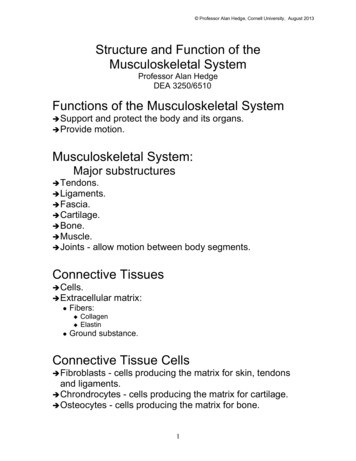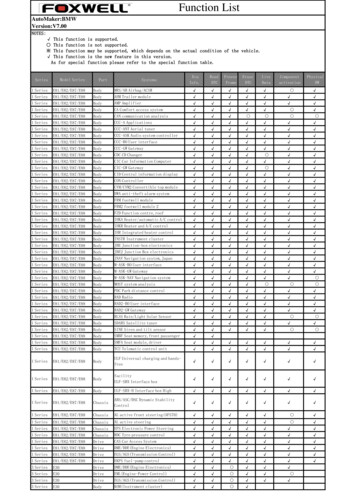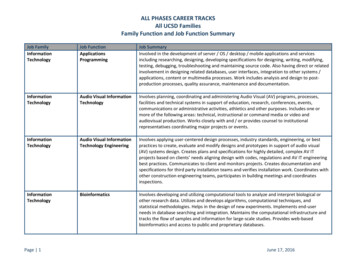
Transcription
Professor Alan Hedge, Cornell University, August 2013Structure and Function of theMusculoskeletal SystemProfessor Alan HedgeDEA 3250/6510Functions of the Musculoskeletal SystemÎ Supportand protect the body and its organs.Î Provide motion.Musculoskeletal System:Major substructuresÎ Tendons.Î Ligaments.Î Fascia.Î Cartilage.Î Bone.Î Muscle.Î Joints- allow motion between body segments.Connective TissuesÎ Cells.Î ExtracellularzFibers: zmatrix:CollagenElastinGround substance.Connective Tissue CellsÎ Fibroblasts- cells producing the matrix for skin, tendonsand ligaments.Î Chrondrocytes - cells producing the matrix for cartilage.Î Osteocytes - cells producing the matrix for bone.1
Professor Alan Hedge, Cornell University, August 2013Connective Tissue MatrixÎ Collagenzzzfibers:Type I - tendons, ligaments, bone, skin.Type II - cartilage.Type III - blood vessel walls.Î Mechanicalproperties depend on fiber types and fiberarrangements.TendonsLigamentsFasciaMechanical Properties of FibersÎ Stress- force on a fiber e.g. weight.Î Strain - % stretching of fibers.Î Elastic limit - point at which the elasticity of the fiber is lost.Î Failure - point at which the fiber breaks.CollagenÎÎÎCollagen molecule - a triple helix of three extended protein chains wrapped around oneanother.Numerous rodlike collagen molecules cross-link together to form unextendable collagen fibrils.Collagen fibrils are striped because of the regular repeating arrangement of the collagenmolecules within the fibril.Collagen fibersÎÎÎÎÎStrength of collagen is 50% strength of bone.Under tension, collagen fibers first elongate slightly and then becomeincreasing stiff until failure.Collagen fibrils have the tensile strength of steel.Elastic FibersElastin - polypeptide chains cross-linked together to form rubberlike, elasticfibers.Elastin molecule uncoils when the fiber is stretched and spontaneously recoilswhen the stretching force is relaxed.Elastic fibersÎÎWeak and brittle fibers.At low loads they strain greatly and can increase 200% in length beforefailure.2
Professor Alan Hedge, Cornell University, August 2013Tendon structureÎ TendonÎ Tendonzzsheath:Synovium - lubricant producing tissue.Synovial fluid - lubricant fluid.Tendons and LigamentsÎ Atcertain points, ligaments surround parts of the tendonsheath to act as:zzPulleys – retinaculae that keep tendons attached to joints whenmuscles contractTendon guides – retinaculae that restrict lateral tendonmovementÎ Ligamentattachments allow tendons to work aroundcorners, as in the fingers and toes.TendonsÎ Tendonsconnect muscle to bone to create movement.Collagen in TendonsÎTendons comprise parallel bundles of collagen fibers, with few elastic fibersand ground substance.Finger MovementTendon and MuscleÎMuscle fiber wrapped in endomysiumFibers bundled into fascicles (up to 200 fibers) wrapped in perimysiumFasciculi bundled together and interspersed with blood vessels and nerves in muscle andwrapped in epimysiumEpimysium and perimysium tissues taper at each end to form tendonsÎHyaline cartilageÎÎÎCartilage: 3 typeszzÎFibrocartilagezzÎSolid matrix, cells (chrondrocytes) densely clusteredpresent in the growth plates at the end of bones and on the articular surfaces of joints. Also presentin the respiratory tract (e.g. trachea).solid matrix, cells widely interspersed among collagen fiberspresent in intervertebral discs,Elastic cartilagezzsolid matrix, cells in small groups between many elastic fiberspresent in ears, nose, epiglottis etc.3
Professor Alan Hedge, Cornell University, August 2013BoneÎÎÎÎÎÎÎÎAdult human skeleton has 206 bones.Babies born with 300 bones but fusion occurs as a child develops.99% of bodies calcium is in bone.80% of bone tissue by weight is minerals.Longest bone (femur)Smallest bone (stapes)Males have slightly thicker and longer legs and armsFemales have a wider pelvis and a larger pelvic cavityBone groupsÎÎAxial skeleton (80 bones)z skull (29 bones)z thorax (25 bones)z vertebrae (33 bones)z Auditory ossiclesz Hyoid boneAppendicular skeleton (126 bones)z pectoral girdle (4 bones)z upper extremity (60 bones)z lower extremity (60 bones)z and pelvic girdle (2 bones)Long bonesÎRound bones comprising:z diaphysis - shaftz epiphyses - 2 expanded endsBone Structure and GrowthÎOssification - processes of bone formation.zzzOsteoblasts - cells that form the bone matrix. They transform intoOsteocytes - cells isolated inside the mineralized bone matrix.Osteoclasts - cells important to bone remodeling.Types of BoneÎÎCancellous (spongy) bone - less dense bone tissue found at the epiphyses ofthe long bones and in axial bones, such as the skull. 30-90% porosity.Cortical (compact) bone - tissue with high proportion of bone. 5-30% porosity.AnisotropyÎAll bone is anisotropic (i.e. its mechanical property changes when loads areapplied in different directions).4
Professor Alan Hedge, Cornell University, August 2013Bone: Mechanical propertiesÎ Mostimportant properties are strength and stiffness ofbone.Î Fractures occur when the bone is loaded to failure.Î Compression fractures are commonest in cancellous bone(e.g. fractured skull)Î Bending and torsional fractures are commonest in corticalbone (e.g. broken tibia).Speed of loading to fracture.Human MusclesÎÎÎMuscular system is 50% of total human body weight. 600 skeletal muscles, which enables the human body to move and stand erect.Skeletal muscles are arranged in overlapping intricate layers:zzSuperficial musclesDeep musclesSkeletal muscleÎÎÎÎÎSkeletal muscle is striated (striped), and excludes cardiac and smooth muscle.Skeletal muscle is under voluntary control.Each muscle is a separate organ.Each muscle is attached to bone by tendons that cross one or more joints.Generally, skeletal muscles generate moments about joints.Muscle fibersÎ Long,cylindrical cells containing multiple nuclei.Î Most of the fiber volume is occupied by the contractileelements - myofibrils.Î Myofibrils show a banding pattern (transverse striation) ofthick myofilaments (myosin) and thin ones (actin).Î The contractile unit of the myofibril is called the sarcomere.Structure of Skeletal MuscleÎ Skeletalmuscle is covered by a fascia called the epimysium.Î The epimysium penetrates and subdivides the muscle into musclefiber bundles called the fascicles (fasciculi).Î Each fascicle is covered by connective tissue called theperimysium.Î Each individual muscle fiber is covered by connective tissue calledthe endomysium.5
Professor Alan Hedge, Cornell University, August 2013Î Connectivetissue provides pathways for nerves and blood vessels contributes to the mechanical properties of the muscle.Skeletal Muscle StructureÎÎActin & Myosin filamentary protein molecules form the sarcomeres, and these bundle to formmyofibrils, which bundle to form muscle fibers.Longest fibers 30 cm long, 0.05-0.15 mm wide, and contain several thousand nuclei.Motor UnitsÎ Motorunit - group of muscle fibers innervated by branches of thesame efferent neuron.Î Functional unit of the muscle.Î Motor units are small in muscles requiring precise control (e.g. eyemuscles), and large in coarse acting muscles (e.g. gastrocnemiusmuscle).Î Motor units work in an “all-or-none” way.Î Progressive contraction occurs because of recruitment of motorunits.SarcomereSarcomere and ContractionMuscle ActionÎÎÎÎActin & Myosin filamentary protein molecules interact to create movement.The Myosin head firmly attaches to the Actin filament.When the Myosin head swivels it pulls the Actin filament forward.Many Myosin head swiveling simultaneously, or nearly so, pull the entire thin actinmyofilament.Muscle fibersÎÎÎÎÎÎSlow twitch fibers (type 1) – S fibers, fatigue resistant, red fibers, slow myosin, contraction times from100-120 msecs.Fast twitch fibers (type II) – white fibers, fast myosin, contraction times from 40- 45 msecs., subdividedinto:z FR fibers (type IIa) –aerobic, fatigue resistantz FF fibers (type IIx) – type IIb, anaerobic, fatigableAverage person has 50% type 1, 25% type IIa, 25% type IIxElite distance runners have more type I fibersElite sprinters have more type IIx fibersExercise can convert type I and IIx fibers to type IIa fibersMuscles and AgingÎÎÎÎÎLoss of muscle mass begins around age 25 yearsBy age 50 there is a 10% loss of skeletal muscle massBy age 80 there is a 50% loss of skeletal muscle massMost loss is loss of muscle fibers and fast fibers atrophy at a higher rate than slow fibersIn aged muscle up to 30% of fibers have morphed into something between a fast and slowfiber6
Professor Alan Hedge, Cornell University, August 2013ÎÎMuscle fibers are never regainedMuscle bulk can be increased with weight training and this thickens the muscle fibersMuscle JunctionsÎMyotendinal junction - area where tendon fibers insert into muscle connective tissue and alsointo bone matrix (Sharpey’s fibers).ÎNeuromuscular junction - motor endplate where nerve fibers connect with myofibrils. In legmuscle one neuron innervates several hundred to 1000 muscle fibers. In finger muscles oneneuron innervates one to a few muscle fibers.Musculotendinous UnitÎSkeletal muscles anchor to the skeleton via either a:z Tendon – narrow cord of connective tissuez Aponeurosis – broad band of connective tissueSkeletal Muscle InnervationÎÎÎNerves (neurons) connect from the brain and spinal cord to muscles.Efferent nerves carry motor instructions for contraction to the muscles.Afferent nerves carry sensory information to the brain.zzÎProprioceptive feedback - muscle tone.Kinesthetic feedback - muscle joint status.Mixed nerves carry a mix of both sensory and motor neurons (e.g. median nerve).Properties of Skeletal MuscleÎ Isometric(static, eccentric) contraction – when the muscle force isless than the external load the muscles contract to change muscletone without changing length. This increases postural stability.Î Isotonic (dynamic, concentric) contraction - when muscle force isgreater than the external load the muscle contracts in length. Thisproduces movement at joints.Î Static contraction is prone to rapid fatigue.Î Dynamic contraction increases blood flow through muscles whichslows fatigue.Muscle Organization at JointsÎÎAgonist muscle - the muscle directly engaged in contraction (e.g. in flexing theelbow the biceps brachii is the agonist).Antagonist - the opposing muscle in relaxation (e.g. in flexing the elbow thetriceps is the antagonist).JointsÎA joint is the union of 2 or more bones. 3 types of joint are found in the body.z Synovial joint (diarthrodial joint) - no tissue between the articular surfaces. Most of thebody joints are this type.z Fibrous joint - fibrous tissue bridge between bones (e.g. skull).z Cartilagenous joint - cartilage bridge between bones (e.g. intervertebral disc in spine).7
Professor Alan Hedge, Cornell University, August 2013Structure of a Synovial JointÎÎÎÎJoint capsule - fibrous capsule around the joint.Synovial membrane - membrane lining the joint capsule and surrounding the synovial cavity.This tissue secretes the lubricating synovial fluid.Synovial cavity (joint cavity) - cavity containing synovial fluid bone endsArticular cartilage (hyaline cartilage) - cartilage covering articular surfaces of the bone ends.Joint degenerationÎÎÎCartilage does not have a good capillary blood supply.Cartilage has a poor ability to repair and regenerate itself.With age, overuse and/or disease, such as arthritis, the articular cartilage degenerates andbone ends make more direct contact, causing inflammation and pain.Intervertebral Disc StructureÎÎÎÎNucleus pulposus - incompressible watery gel contained within an elastic sac.Annulus fibrosis - fibrocartilage lamellae arranged in layers around the nucleus. Fiberorientation varies from layer to layer.End plates - hyaline cartilage end plates protect each end of the disc.Motion segment - 2 vertebrae either side intervertebral disc.Bone and Muscle Loss in SpaceÎIn space, astronauts will experience a deterioration in their musculoskeletalsystem:zz1 to 2 % loss of bone mass each month.Up to 20% loss of skeletal muscle mass within 2 weeks if the astronaut does not exercise: Visiting astronauts ( 2 weeks) exercise 30 minutes/daySpace station astronauts exercise 2 hours/day.8
Bone Î Adult human skeleton has 206 bones. Î Babies born with 300 bones but fusion occurs as a child develops. Î 99% of bodies calcium is in bone. Î 80% of bone tissue by weight is minerals. Î Longest bone (femur) Î Smallest bone (stapes) Î Males have slightly thicker and longer legs and arms Î Females have a wider pelvis and a larger pelvic cavity .











